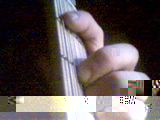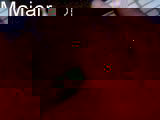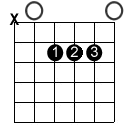
Riff Rundown
Difficulty: Easy – Intermediate
Genre: Rockabilly
For Electric or Acoustic guitar
While Creedence Clearwater Revival may sound like they’re straight from the Mississippi Delta, they are actually out of El Cerrito California. CCR often blended Rock, Country, Blues, R&B, and Rockabilly to create memorable hit songs that have stood the test of time. Their classic hit “Bad Moon Rising” happens to fall under the Rockabilly category.
Rockabilly (rock·a·bil·ly) is a form of popular music combining features of rock ‘n’ roll and bluegrass.
[rock (‘n’ roll) + (hill)billy.]
“Bad Moon Rising” Intro & Verse

Hear it at regular speed (92 bpm):
Here is a backing track that just has the drums and bass to
the riff:
How To Play It
To play this famous riff like the recording
requires you to be able to play barre chords. This is an intermediate
level skill that requires a bit of hand strength, but we’ll
cover a more novice approach to playing this riff with open
chords in a moment. For now let’s take a closer look at the
authentic barre chord approach.
One of the great attributes of the guitar is that a guitarist
can “carry” chord patterns up and down the fretboard
to create new chords. Many of these moveable chords are performed
by creating what is called a Barre with one finger. To play
a barre chords, you must be able to hold all six strings down
with one finger. This can be very difficult at first and may
seem impossible to some novice students, but the muscles in
your hand just need a little training.
Bad Moon Rising uses 2 common barre chord shapes: A and E shape
barre chords. Understand that these two chord shapes can be
used to play any major chord because they can be moved up and
down the neck. We call them A and E shape barre chords because
they are derived from the open chord counterparts they are named
after. The root note (the note the chord is named after) is
the lowest note played in the chord. Therefore when you’re moving
the chord to different frets you can always tell what chord
you are playing by identifying the name of the note the root
falls on.
A Shape Barre Chord
To play an A shape barre chord you must place your first finger
across your first 5 strings and then use your 2nd, 3rd, and
4th fingers to fill out the chord shape. It’s a tight fit! Your
first finger must apply enough pressure to keep the string pressed
against the frets so the notes on the A and high E strings ring
out properly.


Bad Moon Rising uses this chord shape in the first measure
to play a D chord:

The lowest note played is on the 5th fret of the A string which
is a D note. Therefore it’s a D chord.
E Shape Barre Chord
The E shape barre chord spans all 6 strings, but is actually
quite a bit easier to play than the A shape barre chord.


This chord form is used in the 2nd measure of the riff. Notice
that all six notes of the chord aren’t played at the same time,
but alternated in separate strums:

Open Chord Approach
If you’re a beginner guitar player and can’t quite get the
barre chords, you can substitute with standard open chords.
Here are the common open chords for D, A, and G respectively:



To play along just follow the chords at the top of the staff.
Try to strum along as best you can. After a little practice
it should start sound pretty good!
The D6 Chord
The only other thing that may leave you guessing is the D6
chord in the last 2 measures of the riff. This is a D chord
with it’s 6th added. To finger it you should hold the D chord
form with your 1st, 2nd , and 3rd fingers and use your 4th finger
to fret the 6th on the 4th fret.

Chorus
The chorus is just more of the same:


Hear it: